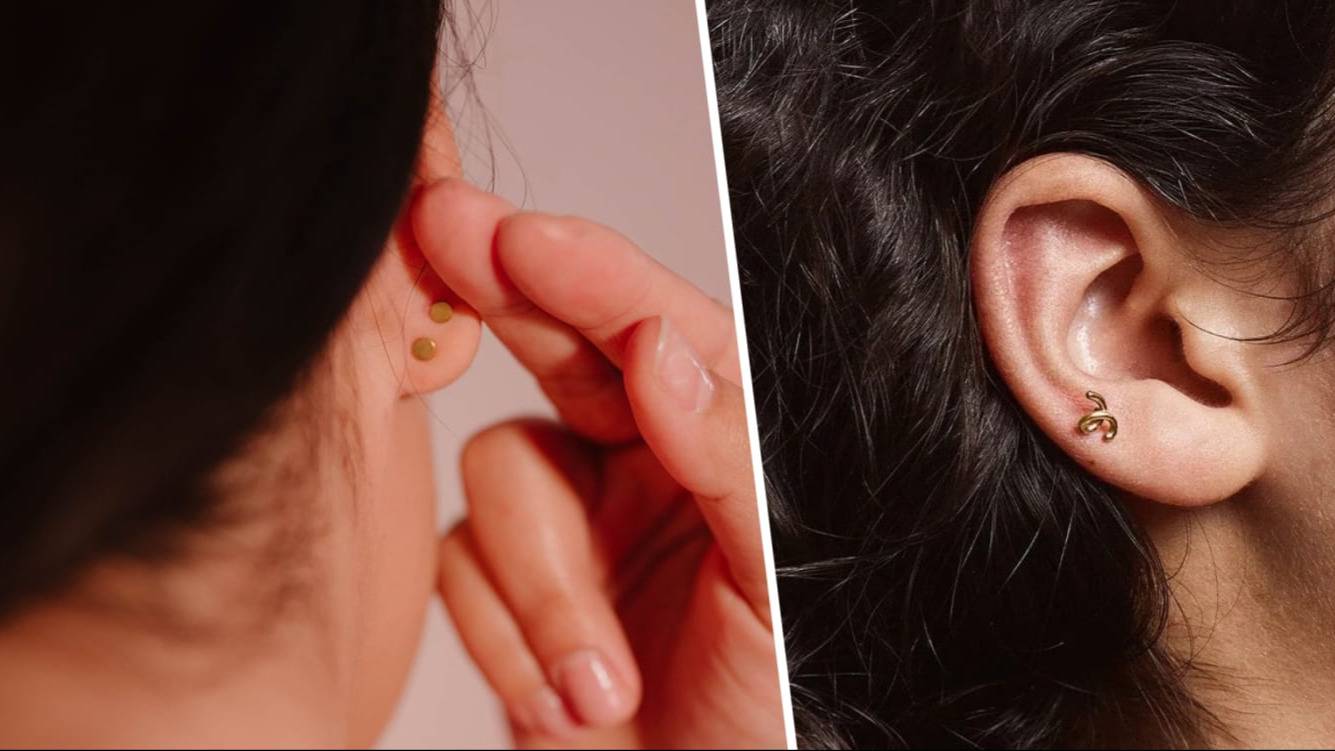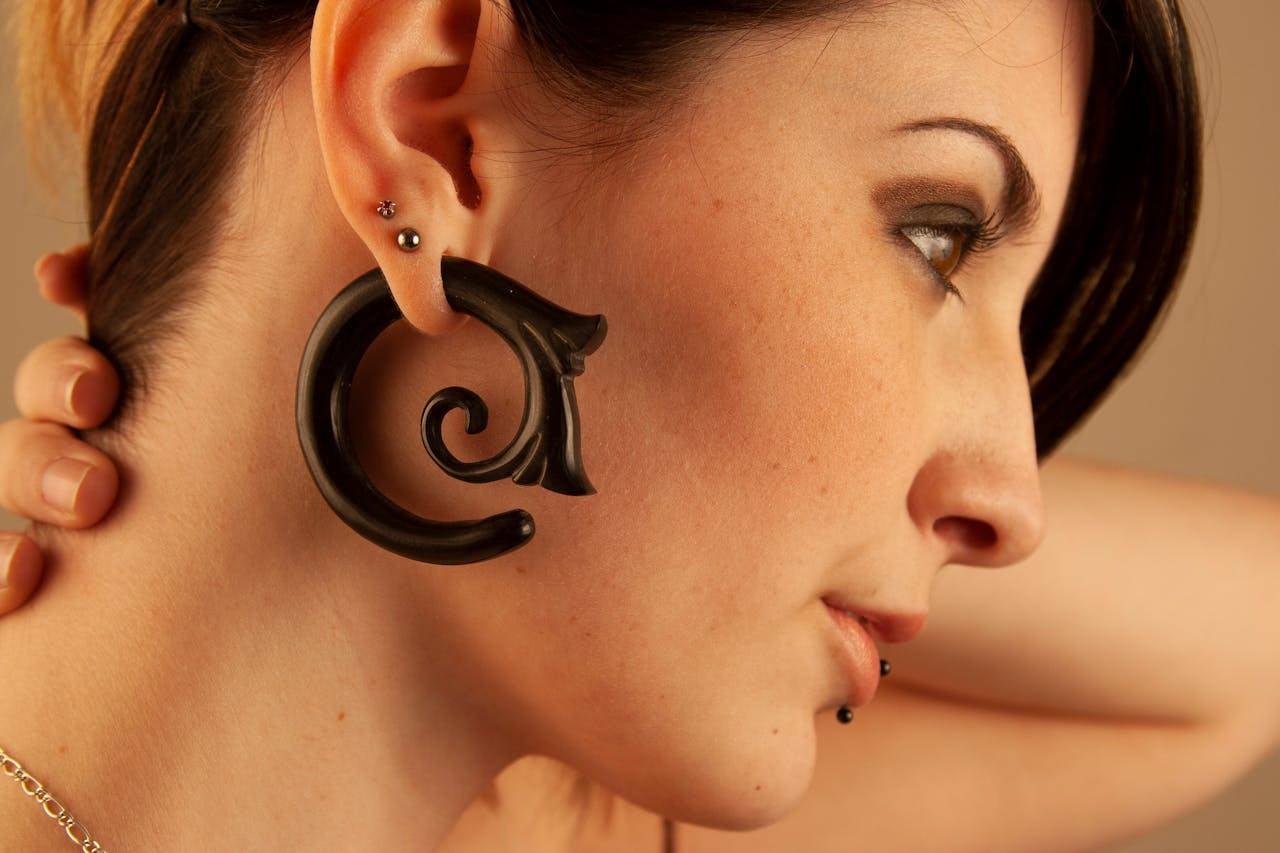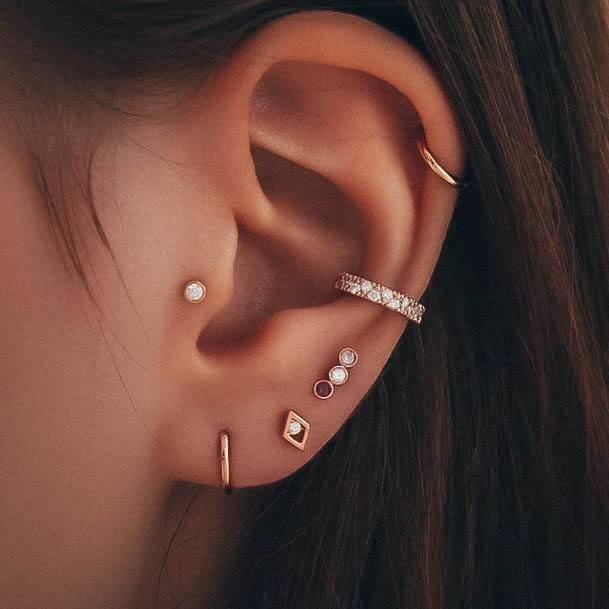
Choose Your Next Piercing With Our Ear Piercing Chart
Getting one or both of your ears pierced is a subtle way to impact your style. Heading into your local piercing shop will always be exciting, no matter how old you are.
Looking for the perfect ear piercing? Our comprehensive ear piercing chart is your ultimate guide to explore various types of ear piercings. From classic lobe piercings to trendy helix and tragus piercings, our chart showcases different styles and placements. Discover the ideal piercing that suits your style and personality. Whether you prefer simple studs or want to experiment with hoops and dangles, our ear piercing chart provides all the information you need to make an informed decision. Trust our accurate and reliable chart to help you achieve the desired look. Explore our ear piercing chart and find your next ear adornment today!
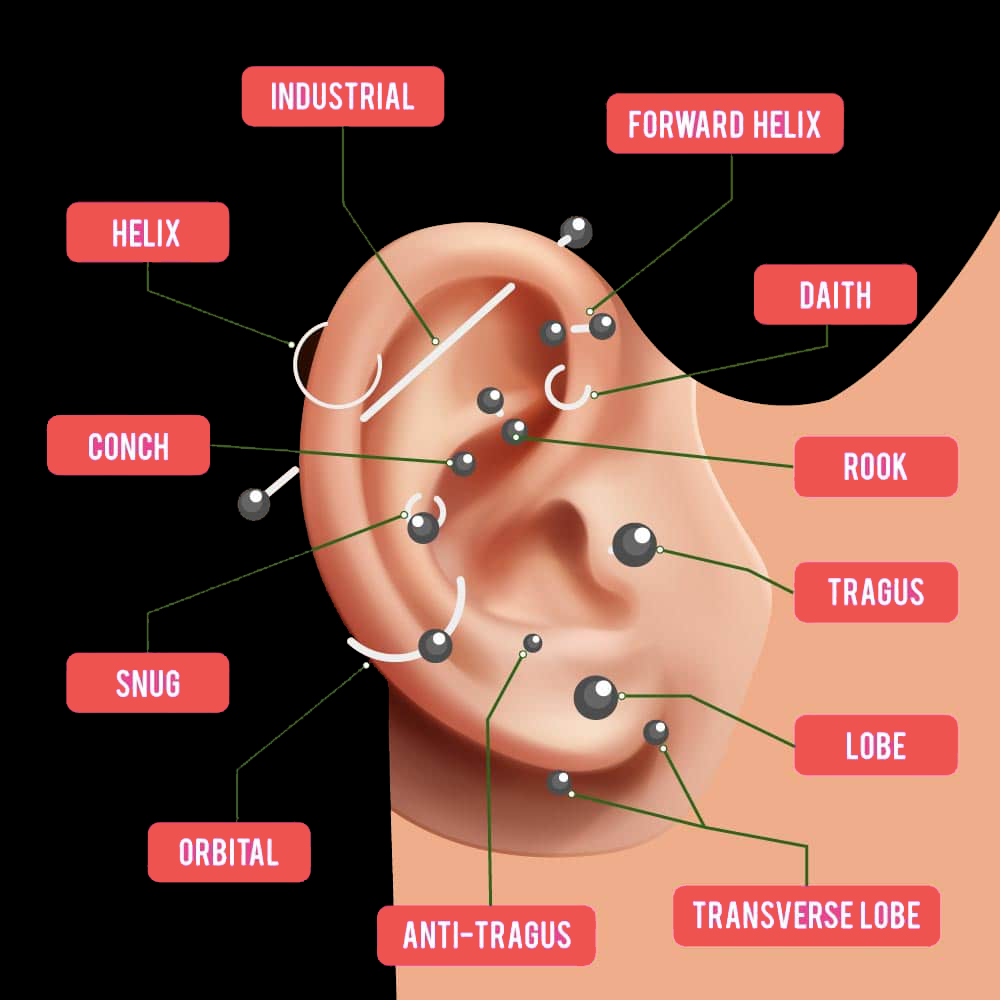
Popular Categories
Different Types of Ear Piercings
Discover the variety of types of ear piercing options available to express your individual style. From traditional lobe piercings to more unique helix and daith piercings, there are endless possibilities to adorn your ears. Explore different types of ear piercing trends including tragus, rook, conch, and orbital piercings. Each type of ear piercing offers a distinctive look and can be customized with different jewelry choices. Whether you prefer a subtle stud or a bold hoop, there is a type of ear piercing that suits your personality and fashion preferences. Learn about the different types of ear piercings to find the perfect match for you.
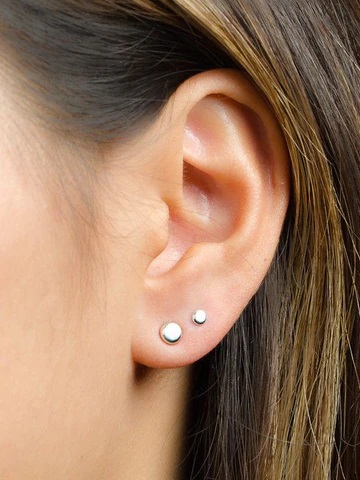
Lobe Piercing
Most people's first piercing is the standard lobe placement. You can expect a lobe piercing to be less painful than other ones.
Your new piercing won't go through any cartilage, making the healing process fairly straightforward. It's an easy-to-maintain piercing but very versatile. You can also opt for an upper-lobe placement, which is a second and/or third piercing slightly above the first one.
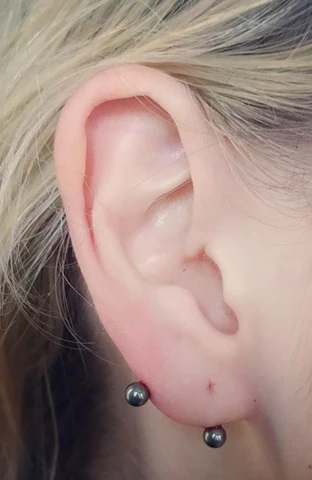
Transverse Lobe Piercing
A barbell gets threaded through your earlobe from side to side with a transverse lobe piercing. A standard lobe placement goes from front to back. You'll end up with a ball on either side of your lobe.
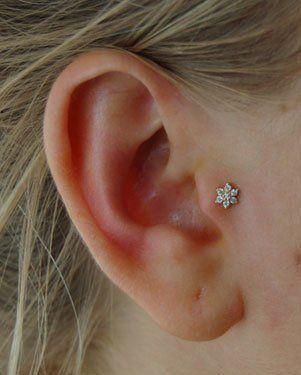
Tragus Piercing
Your ear has a small piece of cartilage that partially covers the ear canal. This is called a tragus placement when you get it pierced. You can wear a stud or a hoop.
You might experience more pain and pressure with a tragus piercing than with a lobe one. That's because the piercer has to go through some cartilage.
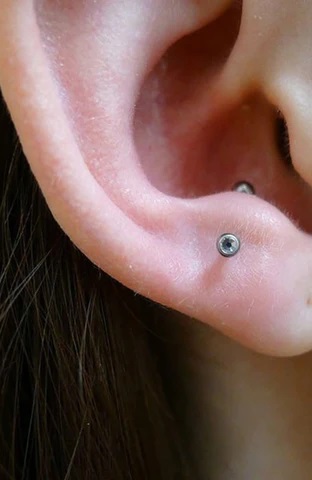
Anti-Tragus Piercing
The cartilage ridge right above your earlobe is the anti-tragus region. These types of piercings require a hoop or a barbell. You'll want to check with your piercer that you have enough room for an anti-tragus piercing, especially if your lobes are stretched or you wear other earrings.
Anti-tragus piercings tend to be more painful than other ones since there is a thicker amount of cartilage to go through. You'll also want to keep the area clean and avoid sleeping on the side that got pierced.
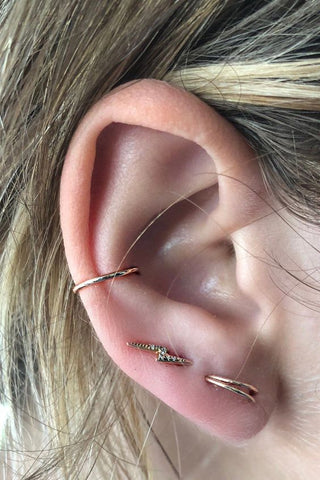
Orbital Piercing
An orbital piercing includes two holes connected by one piece of jewelry. Piercers will usually use a small hoop or a circular barbell.
There are a lot of different placement options to choose from with an orbital piercing. You can opt for the helix to rook or tragus to the conch.
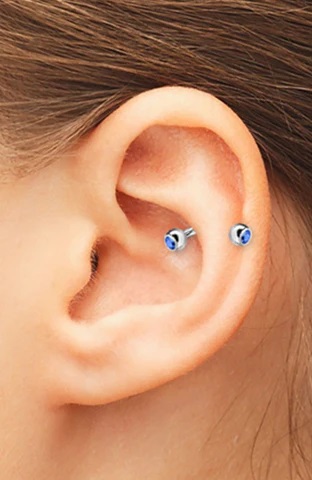
Snug Piercing
Snug piercings are horizontal and sit above the anti-tragus region of your ear. The exit and entrance points of the snug piercing are visible from the front of your ear, making it a unique option.
Keep in mind that not every ear is suitable for a snug piercing. There might not be enough space in that part of your ear, so check with your piercer.
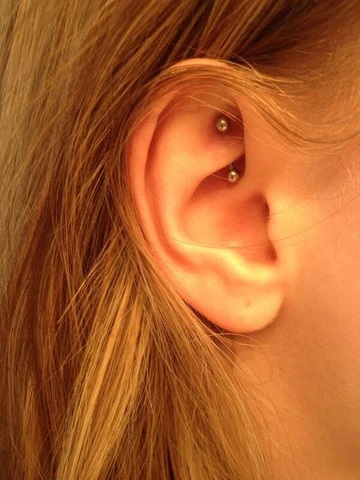
Rook Piercing
A rook piercing goes through your ear's cartilage. The area that gets pierced is in the upper part of your ear, right by the daith placement. The placement is on the ridge between the outer and inner parts of your upper ear.
You can choose a wide range of jewelry, but most people opt for a barbell or hoop. The healing process is a bit longer, typically around six to 12 weeks.
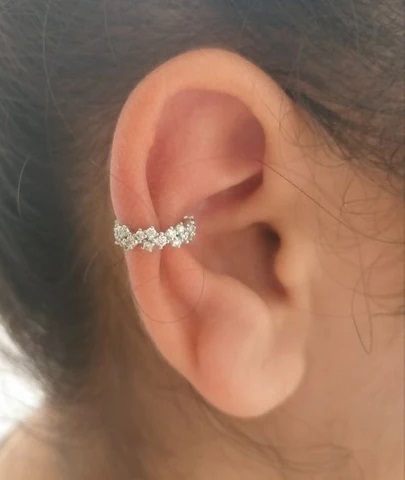
Conch Piercing
A conch piercing can be done on the lower or upper conch part of your ear. This piercing goes through the thickest amount of cartilage, making it more painful than other piercings.
The healing time for a conch piercing can take six to nine months. You'll need to clean it at least two times a day.
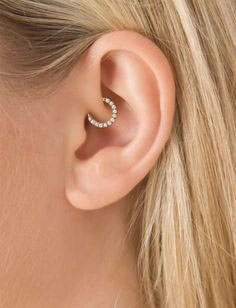
Daith Piercing
Daith piercings are done on the cartilage on the inside of your ear. Piercers will typically insert a hoop. Many people get daith piercings to alleviate migraine symptoms.
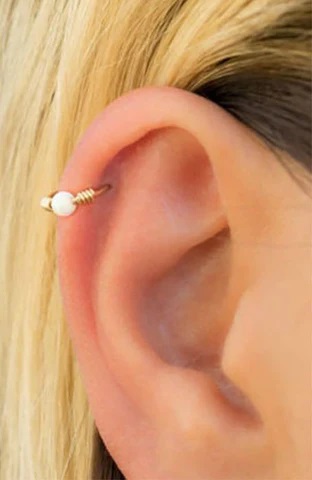
Helix Piercing
Any piercing performed on the upper cartilage of your ear is called a helix piercing. These types of piercings are eye-catching, making them a popular option.
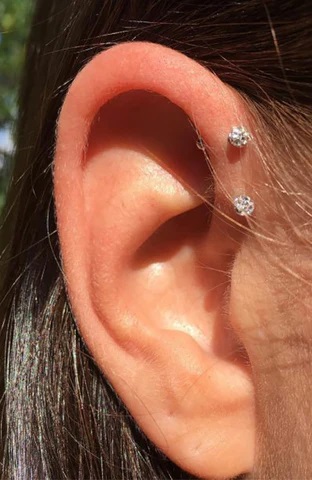
Forward Helix Piercing
Forward helix piercings get placed on the upper and outer cartilage that's closest to your face. The healing time for this piercing is around three to nine months. Once it's healed, it's fairly easy to maintain.

Industrial Piercing
Industrial piercings are any two piercings that get connected by a barbell. They're typically placed on the upper cartilage of your ear. This piercing can be more painful since you're getting pierced twice instead of once.
HOOPS SIZE GUIDE
Location | Gauge/Thickness | Length |
Lobe | 20G / 18G / 16G | 6mm / 8mm / 10mm |
Helix | 18G / 16G | 6mm / 8mm |
Rook | 18G / 16G | 6mm |
Daith | 16G | 8mm / 10mm |
Forward Helix | 18G / 16G | 6mm |
Conch | 16G | 10mm / 12mm |
Tragus | 18G / 16G | 4mm / 6mm |
STUDS SIZE GUIDE
Location | Gauge/Thickness | Length |
Lobe | 20G / 18G / 16G | 6mm / 8mm |
Helix | 18G / 16G | 6mm / 8mm |
Forward Helix | 18G / 16G | 6mm |
Conch | 16G | 8mm / 10mm / 12mm |
Tragus | 18G / 16G | 6mm |
Browse our Collection
Ear Piercing Guide: All Your FAQs Answered!
Curious about getting your ears pierced but not sure where to begin? Welcome to the ultimate ear piercing guide that will take you from hesitant to confident in no time! Whether you're looking to rock a classic lobe piercing or something a bit more daring, we've got all the details you need. From pain levels to aftercare, this guide covers it all.
Ready to find out which piercing suits your vibe and how to care for it? Let's dive in and get those ears ready for some serious sparkle!
The Various Types of Ear Piercings
Before you decide to get your ears pierced, it's helpful to know the various options available. Here are some of the most popular types of ear piercings:
Lobe Piercing: The most common type, done on the fleshy lower part of the ear. It's typically less painful and heals quickly.
Upper Lobe Piercing: Similar to a lobe piercing, but positioned higher on the earlobe.
Helix Piercing: Located on the upper cartilage of the ear. The pain level is slightly higher due to the cartilage.
Forward Helix Piercing: Situated on the outer rim of the ear, near the face.
Conch Piercing: Done in the middle part of the ear's cartilage. It can be positioned in the inner or outer conch.
Daith Piercing: Found in the inner fold of the ear, believed by some to help with migraines.
Tragus Piercing: Located on the small, thick piece of cartilage just above the ear canal.
Rook Piercing: Done on the ridge of cartilage between the outer and inner ear.
Ear Piercing Pain Level
A common concern for many is the ear piercing pain level. The pain varies depending on the type of piercing and your pain threshold. Generally, lobe piercings are the least painful, while cartilage piercings can cause more discomfort. Here's a quick overview:
Lobe Piercing: Minimal pain, quick healing
Helix and Forward Helix: Moderate pain, longer healing time
Conch, Rook, and Tragus: Higher pain level due to thicker cartilage
Helpful Ear Piercing Aftercare
Taking care of your new piercing is essential to prevent infections and promote healing. Here are some ear piercing aftercare tips:
Clean Your Piercing Twice a Day: Use a saline solution or a piercing-specific antiseptic. Avoid alcohol-based products as they can dry out the skin.
Do Not Touch or Twist the Jewelry: Twisting the jewelry can irritate the piercing and introduce bacteria, leading to infections.
Avoid Swimming: Chlorinated water and bacteria in pools or natural bodies of water can irritate your piercing. Wait until it's fully healed before swimming.
Sleep on Your Back: If you have a new cartilage piercing, avoid sleeping on the pierced side to reduce pressure and discomfort.
Check the Tightness: Occasionally check that the jewelry isn't too loose or too tight, especially if it's a screw-on type.
Common Aftercare Mistakes to Avoid
- Using alcohol or hydrogen peroxide on the piercing
- Over-cleaning, which can dry out the skin
- Removing jewelry too early
- Ignoring signs of infection
Common Ear Piercing Questions
When considering a new piercing, it's natural to have questions. Here are answers to some of the common ear piercing questions:
How long does it take for an ear piercing to heal?
Lobe piercings typically heal within 6-8 weeks, while cartilage piercings can take anywhere from 3 months to a year.
Can I change the jewelry before my piercing heals?
It's best to wait until the piercing is fully healed. Changing jewelry too soon can irritate the area and increase the risk of infection.
What should I do if my piercing gets infected?
Clean the area with a saline solution, and avoid removing the jewelry. If symptoms persist, seek advice from a piercing professional or a healthcare provider.
Can I get multiple piercings at the same time?
Yes, but be mindful of your body's healing capacity. It might be best to start with one or two and then add more once they've healed.
Do certain piercings hurt more than others?
Yes, the pain level varies based on the type of piercing and its location. Cartilage piercings usually hurt more than lobe piercings.
Ear Piercing Tips for a Smooth Experience
Ready for your piercing? Here are some helpful ear piercing tips to make the process as smooth as possible:
Choose a Piercing Professional: Always go to a reputable and experienced professional. Check reviews and ask for recommendations if you're unsure.
Consider Your Lifestyle: Think about your daily activities and how a new piercing might affect them. For instance, if you wear a headset regularly, a tragus or conch piercing might not be the best choice.
Avoid Piercing Guns for Cartilage: Piercing guns can cause more damage to cartilage compared to needles, leading to a painful healing process.
Ask About Jewelry Options: Some metals may cause allergic reactions. Make sure to choose high-quality, hypoallergenic materials.
Preparing for Your Piercing Appointment
- Eat a light meal beforehand to avoid feeling faint
- Wear comfortable clothes and tie your hair back
- Bring a friend for moral support if you're nervous
- Ensure the piercing studio is clean and follows proper hygiene protocols
Signs of Healing and What to Expect
Understanding the healing process can help set realistic expectations. Here's a general timeline for what you might experience:
First Few Days: Some redness, slight swelling, and tenderness around the piercing site. These are normal initial reactions.
Weeks 2-4: The area may still be sensitive, but the pain should decrease. Continue with regular cleaning.
After 6 Weeks (for Lobe Piercings): Most lobe piercings will be healed or close to it, and you can switch to other jewelry.
3-6 Months (for Cartilage Piercings): Cartilage piercings take longer to heal. Be patient and continue cleaning for the full duration.
Our Ultimate Ear Piercing Guide
Getting an ear piercing is an exciting way to express yourself, but it's important to be informed. Hopefully, this ear piercing guide has covered all the essentials for you.
If you're ready to adorn your ears with beautiful jewelry, Body Pierce Jewelry has you covered. Our vast collection guarantees that there's something for everyone, no matter your taste. Shop with us and find the perfect pieces to make your ear piercings stand out!
Visit our website today and feel free to reach out if you have any questions.
Shop Our Selection of High-Quality Ear Piercing Jewelry
Keep in mind when choosing where to get your next ear piercing that everyone's pain threshold is different. Talk with your piercer about any concerns you may have. They'll let you know what to expect and how to care for your piercing.
Body Pierce Jewelry carries a large collection of premium ear piercing jewelry for all types of ear piercings. Shop our collection today.



